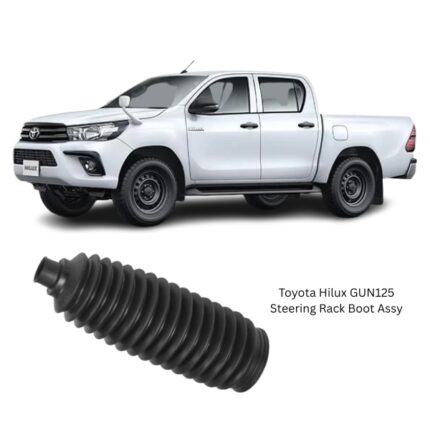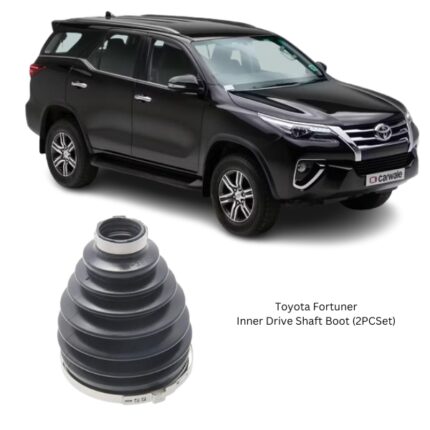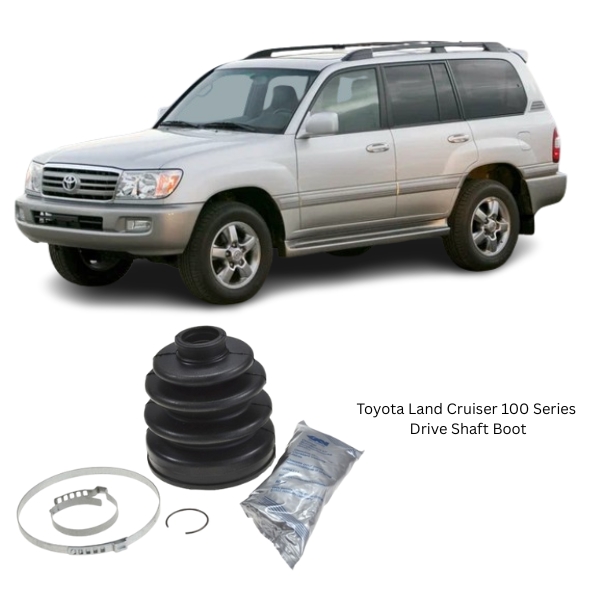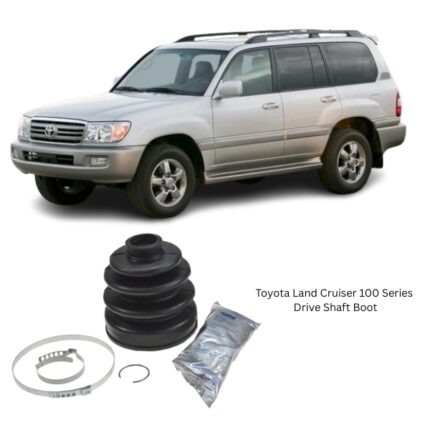-17%
Get Toyota LandCruiser Prado 100 Series Drive Shaft Boot 04438-60021 in Kenya
The Drive Shaft Boot, also commonly referred to as a CV boot (Constant Velocity boot), is an essential protective component in a vehicle’s drivetrain. While it may appear as a simple rubber or thermoplastic cover, the drive shaft boot plays a vital role in ensuring the smooth, reliable, and long-lasting performance of the constant velocity joints (CV joints) that enable efficient power transfer from the transmission to the wheels—especially in vehicles with front-wheel drive, rear-wheel drive, or all-wheel drive systems.
Fitted over the CV joints located at both ends of the drive shaft (inner and outer), the boot seals and protects the joint from contaminants such as water, dirt, and debris while retaining the high-temperature lubricant needed for the joint’s constant rotation and articulation. This simple yet critical function preserves the health of the drivetrain and contributes directly to vehicle performance, ride smoothness, and component durability.
Purpose and Functionality
The primary function of a drive shaft boot is to protect the CV joint while allowing it to move freely and flexibly with the suspension and steering movements. These joints must constantly rotate and pivot as the vehicle turns, accelerates, brakes, and travels over bumps or uneven surfaces.
Key Functions:
-
Seal Against Contaminants
The boot forms a protective barrier around the CV joint, blocking dust, water, mud, sand, road salt, and other abrasive particles from entering and damaging internal components. -
Containment of Grease
CV joints require consistent lubrication to operate smoothly. The boot retains the specialized grease inside the joint, even during continuous movement and flexing. -
Flexibility and Articulation
The drive shaft boot expands and contracts in sync with the joint’s movement, maintaining a perfect seal without impeding mobility. -
Component Longevity
By keeping the CV joint clean and lubricated, the boot significantly extends the joint’s operational life and prevents premature failure.
Design and Materials
The Drive Shaft Boot is engineered with a high degree of flexibility and strength to accommodate thousands of joint rotations and directional changes throughout its life. The boot’s structure is optimized to provide movement without breaking the seal.
Components and Structure:
-
Bellows Design
The boot features accordion-style folds (bellows) that compress and extend during joint articulation. This allows maximum range of motion while minimizing material fatigue. -
Inner and Outer Collar Ends
These ends fit tightly over the joint housing and shaft, secured with metal clamps or heavy-duty zip ties to maintain a firm, sealed connection.
Material Composition:
-
Neoprene Rubber
Common for its excellent oil, heat, and chemical resistance, as well as its ability to remain flexible over time. -
Thermoplastic Elastomers (TPE)
Often used in modern applications for their lightweight properties and long service life under exposure to harsh environments. -
Silicone Rubber (High-Performance Applications)
Ideal for extreme temperature conditions and high-load applications due to superior flexibility and thermal stability.
The selected material must resist mechanical wear, UV degradation, temperature extremes, and exposure to oil and grease.
Types of Drive Shaft Boots
-
Outer CV Boot
Located at the wheel-side joint of the drive shaft. This boot experiences the highest levels of movement due to steering input and suspension travel. -
Inner CV Boot
Positioned at the transmission-side joint. Although it faces slightly less motion, it still endures rotational and vertical suspension forces.
Both types serve identical functions but may differ in size, material thickness, or design to match their respective mounting points and movement dynamics.
Performance Advantages
When functioning correctly, a Drive Shaft Boot provides the following performance benefits:
-
Smooth Power Delivery
Ensures consistent torque transfer from the engine to the wheels without interruption or friction losses. -
Vibration and Noise Reduction
Maintains lubrication and alignment within the joint, reducing clunking, rattling, or grinding sounds. -
Improved Vehicle Handling
Preserves precise movement of the drive shaft during steering and suspension articulation. -
Reduced Maintenance Costs
Protects the CV joint from damage, extending the lifespan of expensive drivetrain components. -
Reliable Operation in All Conditions
Engineered to function in mud, water, dust, snow, and high-temperature environments without losing performance.
Signs of a Worn or Damaged Boot
Over time, the Drive Shaft Boot may degrade due to exposure to road debris, age-related cracking, or continuous flexing.
Common Symptoms of Boot Failure:
-
Grease Splatter on Wheels or Undercarriage
Indicates that the boot has split or torn, allowing grease to escape. -
Visible Cracks or Tears in the Boot
Inspection reveals holes or cuts, especially in the folds or clamp areas. -
Clicking or Popping Noises While Turning
Caused by joint damage due to loss of lubrication or contamination entering a torn boot. -
Excessive Vibration While Accelerating
Suggests imbalance or wear within the CV joint caused by improper boot function. -
Premature CV Joint Wear
Leads to expensive repairs if boot damage goes undetected.
Installation and Replacement Process
Replacing a Drive Shaft Boot is a preventative repair aimed at saving the CV joint from failure. It can be done independently or during CV joint or axle shaft replacement.
Typical Replacement Steps:
-
Lift and Secure Vehicle
Gain access to the axle shaft and remove the wheel for inspection. -
Remove the Drive Shaft
Depending on the vehicle, this may involve detaching suspension and steering components. -
Disassemble the CV Joint (if required)
Carefully disassemble to access the damaged boot and clean the joint thoroughly. -
Install New Boot
Slide the replacement boot into place and secure it with clamps or bands at both ends. -
Repack with Grease
Fill the joint cavity with high-temperature CV joint grease before sealing. -
Reinstall Shaft and Recheck
Torque components to spec and confirm boot placement is secure.
Tip: Always replace both boots on an axle if one is found damaged, and consider replacing both axles if mileage is high.
Inspection and Maintenance Tips
-
Visual Checks During Routine Service
Check for surface cracks, leaks, or displacement of clamps during tire rotations or oil changes. -
Avoid Road Hazards
Deep potholes or off-road driving can stress and tear the boot prematurely. -
Regular Grease Inspection
Leaking grease or shiny residues on nearby parts indicate a compromised boot.
Proactive inspection and timely repair can prevent expensive CV joint or axle shaft replacements.
Follow us on Facebook for more parts.





Reviews
Clear filtersThere are no reviews yet.